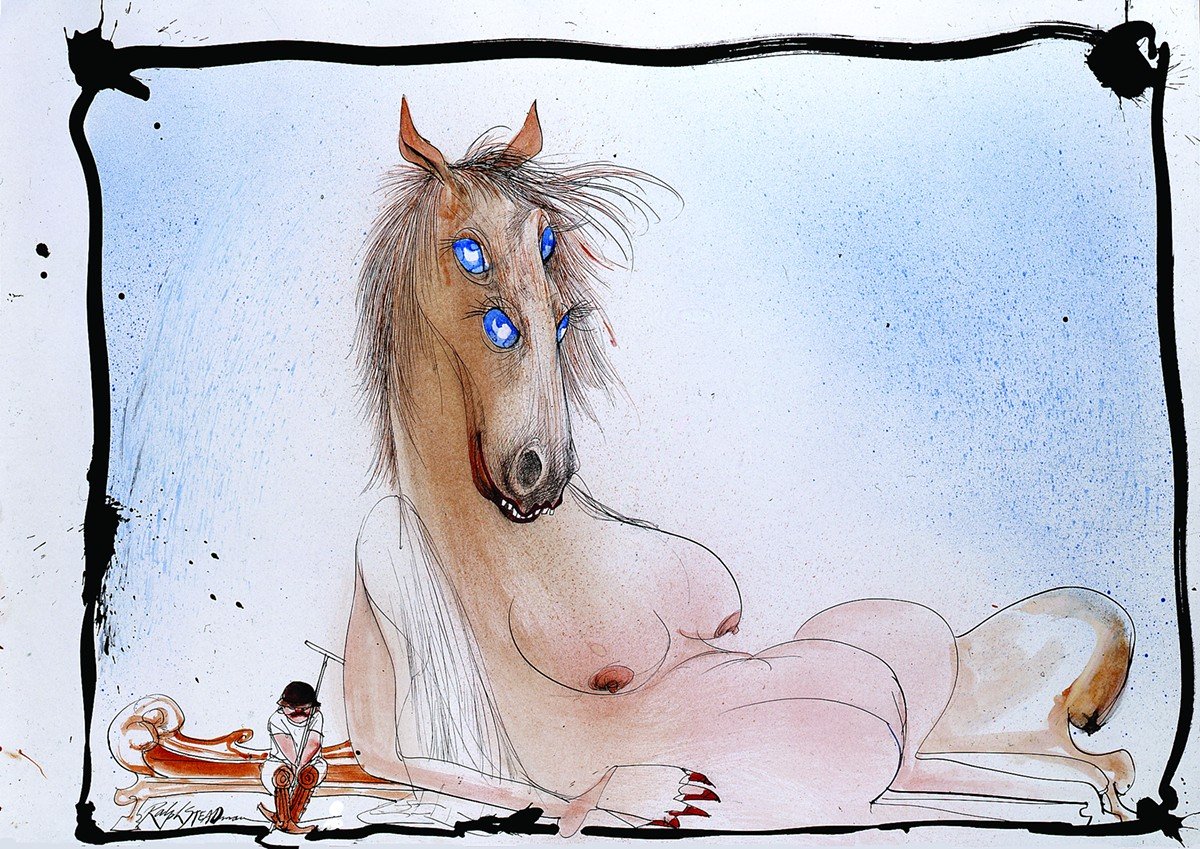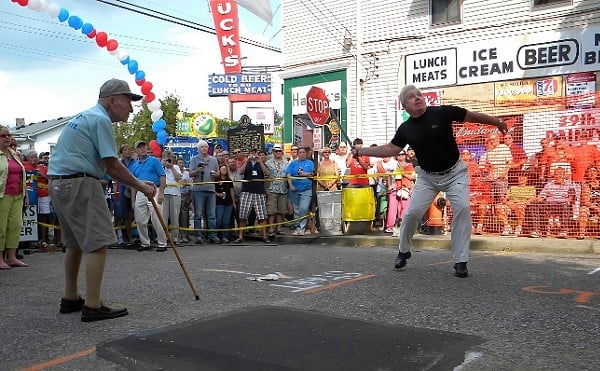This week marks 46 years since Scanlan’s Monthly published Hunter S. Thompson’s legendary piece, “The Kentucky Derby is Decadent and Depraved,” a subjective and hilarious report of the 1970 Kentucky Derby. The relatively unknown publication had commissioned the Louisville-born writer to cover the race and assigned British artist Ralph Steadman to tag along and do the illustrations. The result was a 7,200-word piece that dismissed the use of conventional sports journalism in favor of a first-person account of an odyssey at Churchill Downs — a style that Boston Globe magazine editor Bill Cardoso referred to as “pure gonzo journalism.” Thompson embraced the term, and “Gonzo” was born.
The 94th running of the Kentucky Derby took place May 2, 1970. It was hot and humid, but that didn’t stop a young stallion named Dust Commander from leaving 16 other thoroughbreds in his own dust and winning the race by a commanding five and a half lengths. The moment he crossed the finish line, he became a national sensation, if not a salve to the rude happenings of the time.
The country had grown tired of the Vietnam War, underscored by widespread anti-war protests and riots in every major city, including New York, Chicago and Los Angeles, that culminated in the shooting deaths of four students by National Guardsmen at Kent State University. A beleaguered President Richard Nixon wrestled with a racially tense and bitter American public. And by Derby Day, America was ready for a distraction — a hero, a savior or anything to shield the American psyche from the horror of war, the ugliness of politics and the pain of our own personal struggles. Something. Anything. Even a damn horse.
At the time, Thompson was enjoying accolades for his first book, “Hell’s Angels: The Strange and Terrible Saga of the Outlaw Motorcycle Gangs,” which Thompson wrote while embedded with a chapter of the infamous Hells Angels biker gang for a year. Steadman had been in the United States for only a short time, juggling freelance gigs as an artist and illustrator.
Heading to the Derby assignment, Thompson and Steadman had never met each other and relied only on general physical descriptions. “Hunter and I looked for each other for three days and met ... outside the press room ... overlooking the track,” Steadman wrote me in a recent email.
From the moment they met, Thompson used the British artist as a comedic punching bag. “Well, they said you were Weird! But not that Weird,” Thompson said, according to Steadman. “I was sporting a small goatee beard at the time.”
And Thompson’s vicious prodding continued. “The whole place will be jammed with bodies, shoulder to shoulder,” he warns Steadman in “The Kentucky Derby is Decadent and Depraved.” “It’s hard to move around. The aisles will be slick with vomit; people falling down and grabbing at your legs to keep from being stomped. Drunks pissing on themselves in the betting lines. Dropping handfuls of money and fighting to stoop over and pick it up. Don’t worry. At the first hint of trouble I’ll start Macing everybody I can reach.”
Luckily, no Mace was needed, and the pair escaped Churchill Downs relatively unscathed, save for a few dollars lost at the wagering lines. But not before they witnessed an interview with Robert Lehmann, the owner of Dust Commander, whom Thompson described as “a dapper little man.” Steadman captured the moment in one of his illustrations featuring a melee of contorted faces, a stilt-legged, thick-cocked Dust Commander saddled by a puny jockey.
Staring at the illustration, I imagined Thompson and Steadman at the race — surrounded by glorious chaos and terrible beauty. But I grew curious about the jockey — the little man atop the brown odd-toed ungulate. What about him? Did he notice anything particular about the race that sparked Gonzo history?
His name is Mike Mangenello, out of Lexington, Kentucky. I tracked him down and pressed him for answers. “He felt good going into the gate,” Manganello said of Dust Commander. “I was very confident. He had just come off winning the Blue Grass, and he did it in extremely good fashion.” But even Mangenello said he was surprised by the dominant performance. “Nobody thinks you’re going to win the Derby in five lengths,” he added. “He felt so strong at the finish.”
Manganello was no stranger to racing in front of big crowds. He’d already landed four consecutive wins at the Turfway Park Fall Championship Stakes. But he described a wild frenzy coming into the final stretch at the Kentucky Derby. “It’s like everything is coming out from inside you,” he said. “You hear the roar of the people. It’s vibrating through your whole body.” He sighed as he recalled the moment he crossed the finish line. “I have never felt anything like that in my entire life.”
Decadent.
And what about Dust Commander’s owner, Mr. Lehmann, who Thompson reported as having “bagged a tiger” before the race. “Oh, yes,” Manganello said. “He was a big game hunter. He was on commission from India to kill this man-eating tiger that was raiding the villages. And the day before the Derby is when he finally bagged the tiger and was able to fly out of there and make it just in time for the Derby.”
Depraved.
And the star of the show, Dust Commander — how’d he fare after the race? “He injured himself,” Mangenello said. “He had some filling in his leg after the Derby.” Dust Commander would place a disappointing ninth in the Preakness two weeks later. His racing days were done. But like any good old Kentucky boy, he retired as a farm stud, siring a clan of thoroughbreds into Gonzo perpetuity. He died in 1991 and was buried in an unmarked grave somewhere on a farm in Paris, Kentucky.
In 2013, his remains were located and transported to the Kentucky Derby Museum at Churchill Downs, which now serves as his final resting place. Visitors can celebrate Dust Commander in pure Gonzo fashion. In fact, I stopped by on April 19, paid my respects, then opened my flask and swallowed a shot of Woodford Reserve. It was too early for Mint Juleps, at least by a few weeks.
Then, it was off to the Pendennis Club in downtown Louisville, whose website identifies itself as “a gathering of friends, where decency, decorum, civility, good manners and the social graces are still very much in style.” In “Decadent and Depraved,” Thompson describes an incident at the posh social club in which Steadman was “attacked” by a man after the Derby. The drunkard became enraged, thinking Steadman was after his wife. Thompson describes the incident as among the most horrible memories of the weekend — “the emotional effects were massive,” he wrote.
I decided to show the Pendennis ghouls some Jersey-style manners and pay them an unexpected visit. I sported a jacket and tie, suspenders and a pinky ring, combed my hair back and summoned an UberX car from my room at the Brown Hotel. The driver was a big Russian dude with an eye patch and who could barely fit in the front seat of the Lincoln Town Car. His fingers wrapped the steering wheel in a tangle of twisted kielbasas. When we arrived at the Pendennis Club, I handed Igor an extra $20 to hang around until I returned. “It won’t be long,” I told him. “OK,” he grunted.
I was greeted by a gawky man at the door who asked for my membership card. Instead, I introduced myself and flashed my gold Kentucky Colonel card. But he wasn’t impressed. “I’m from New Jersey,” I told him, trying to soften my fuhgeddaboudit-Joysey-boy accent. “The Mets Poet,” I told him. “I’m doing a story for LEO.”
The gawk motioned to a taller grey-suited guy standing in the foyer. “This gentleman has requested to see the grounds. He plays baseball for the New York Mets. He knows Leo.” I shook my head, “No, I don’t play for the Mets, I write ... “ Then the tall guy interrupted. “Of course! Leo Bailey was expecting you today.” I was dumbfounded but delighted. “A game of billiards, sir” he asked. “In matter of fact, yes,” I said. He led me into a large room with a marble tile floor, walls finished in dark walnut wood, then to an even larger room. And alas, we entered the Billiard Room where the infamous Steadman incident took place.
The man assured me that Leo would be joining me soon. “Thanks,” I said, and he left. Who the fuck is Leo, I thought. I better do my thing and then find a way out of here before he arrives. I might get cue-clubbed like Steadman. I stood for a moment in the rich man-cave and basked in its afternoon quietude. I spun around slowly on the balls of my feet and then approached one of the billiard tables. I ran my hand along its immaculate green felt, which sported no sign of chalk dust. Adjacent to the table was a cue rack. I picked one of the weighty wands, went to the table and then leaned into a pose as if to hammer a cue ball into a break shot.
I imagined Steadman being congenial, making drawings for the rich and powerful and handing them out like confetti to the wealthy drunks. I shot him an email on my phone asking what the hell happened at Pendennis? His response was swift.
“I just kept drawing — and I happened to do a scribble of one of the Wives. She took one look at it — scowled and said ‘That ain’t purty!?’ ‘Arm purty – ain’t A(I) !???’ She grabbed my Sketchbook and Pen — started scratching maliciously at the paper and the Husband began to look aggressively at me! I think he was going to hit me with the Billiard Cue and Hunter stood between us. I guess I was drunk also! — so I thought I was doing ‘funny drawings’ as a gesture of Friendship — but I fear that in Kentucky a drawing or ‘likeness’ can be misconstrued as a bare-faced INSULT!!”
Then, I opened the attachment to Steadman’s email — a grotesque illustration. The longer I looked, the more it looked like me; a gnarly beast with four horns sprouting from its skull. And there was Kentucky musician Tyrone Cotton, a surly-looking shirtless and contorting grotesque. And a bespectacled red-horned behemoth with mouth agape, poet Ron Whitehead.
Was this a trick? Did Steadman grow wise to Thompson’s pranks and become an expert prankster himself? I suddenly empathized with the man at the Pendennis Club who was going to put a billiard cue to Steadman’s head. I chuckled and put the phone back in my jacket. Then I reached into the billiard table’s corner pocket, and I pulled out a cue ball. I put it up to the light shining through the windows of the Pendennis club and stared at its shiny white surface. Then I fell into a gentle daydream...
And suddenly there I was, back to that overcast afternoon on Derby Day, 2013, with Whitehead and Cotton, among the mad patrons at Churchill Downs, wrestling with other beasts, fighting to place a bet, grab a drink and punch our way to the front row and get a whiff — and taste — of the scrumptious mud-caked manure kicked up by the hooves of googly-eyed stallions.
That’s where we found ourselves — two poets and a musician. A black musician — one who should’ve been made a Kentucky Colonel long ago. One of the few African Americans in the crowd of 150,000. We felt he got stiffed, so Ron and I gave Cotton, who grew up in Louisville, the honorary title of General. As our outranking officer, Gen. Cotton led us through an army of thrill-seekers in oversized hats and oversized suits girdling oversized asses in small seats. We had lost a third colonel the day prior when Crazy Tony from New Jersey became a victim of avarice and indulgence at the Kentucky Oaks race. His legs swelled, knees infested with gout. The prescription drugs didn’t work, so he gave up in pain and collapsed in the stands — a crippled, castrated gelding.
But at Churchill Downs, only the strong survive. Gen. Cotton led us to the bar and then to the wagering windows where I slapped down a $100. I had won $240 in the earlier races, so I felt lucky. I wagered $80 on Normandy Invasion to win, and a $20 superfecta — which I knew was a fool’s bet, but with a $570,000 payout, what the hell. Tyrone spread $100 across Goldencents, Overanalyze, and Will Take Charge to place. Ron opted to flirt with a couple of old ladies who were playing with his beard and marveling at the bejeweled embroidery on his custom made sport jacket. Orb won the race by two and a half lengths. Tyrone and I lost everything, and Ron won the hearts of two old ladies. After the race we raised our glasses.
“To decadence and depravity!”
As we poured out of Churchill Downs, people staggered and fell over each other. A woman projectile-vomited onto a half dozen people who seemed unfazed by the acidic splatter. There were screams, laughter and a man with a bullhorn shouted in tongues — sounds reminiscent to those described in Dante’s “Inferno.”
We paraded down side streets, searching for Tyrone’s car. People were selling barbecue beef, hot dogs and drinks from their front yards. A couple of friendly, buxom black girls yelled over, “Hey beer! $3 a cup, two for five!” Ron ran up, lay in their laps and posed for a picture with the girls, laughing as they stroked his long white beard. Tyrone turned to me and said, “It’s a white man’s world!” A few blocks down, a stretch limousine attempted to do a u-turn. Ron leapt in front of it, raised his arms and yelled, “The Kentucky Derby is decadent and depraved!”
We finally found Tyrone’s car right where we parked it — on a public street where locals demanded $20 to “protect” it while we were gone. Not a scratch. All four tires intact. We got home, swallowed a few beers and crashed for the night.
The next morning I woke to ringing in my ears. I stared at the ceiling fan above the bed, its blades spinning like a helicopter over Churchill Downs. I could still hear the bullhorn, the crowd and the throbbing madness — and Ron’s proclamation in front of the stretch limo, “decadent and depraved!” I continued staring at the ceiling fan and grew hypnotized by its whirling motion...
“Leo, he’s this way,” a man’s voice echoed through the Pendennis Club. “In the billiard room!” I put the ball down on the pool table and darted for the exit. Thank God Kielbasa fingers was still there. I hopped in the car and yelled, “Igor! To the Brown Hotel!”
My cue ball daydream almost betrayed me. But I escaped unscathed, just as Thompson and Steadman did from the same room back in 1970.
When I got back to the Brown Hotel, I went to the lobby bar and ordered an Old Fashioned. And I pondered Thompson’s words. “So the face I was trying to find in Churchill Downs that weekend was a symbol, in my own mind, of the whole doomed atavistic culture that makes the Kentucky Derby what it is.”
Then, I opened up my phone and looked again at the faces in the illustration Steadman sent me — with the words, “Filthy Scribblings! Hope this is OK for you!”
And it dawned on me. This filthy scribbling depicts none of us in particular — not me, Ron or Tyrone, but the glorious, grotesque mess of humanity at large. Because anyone who has experienced the Kentucky Derby knows to what vile depths people sink each year on the first Saturday in May and transform into the worst possible versions of themselves. No, ourselves. Decadent. Depraved.•
Frank Messina is an award-winning poet, actor and artist from New Jersey. Fans refer to him as “The Mets Poet.” He serves as Artistic Advisor to the Jack Kerouac Writer-in-Residence Project.






